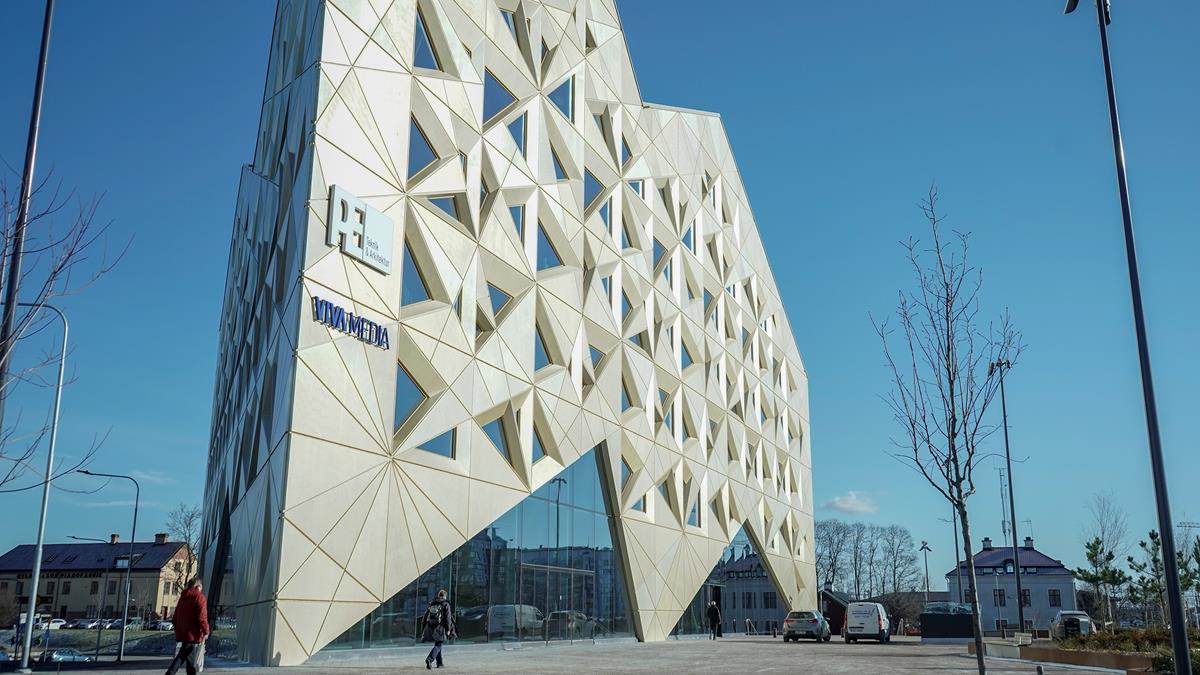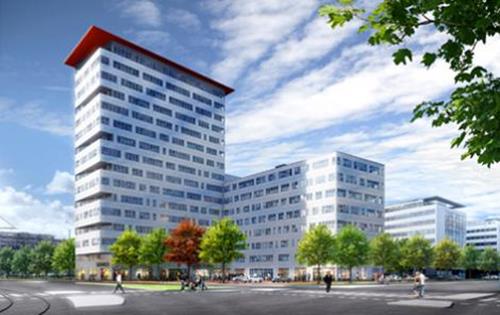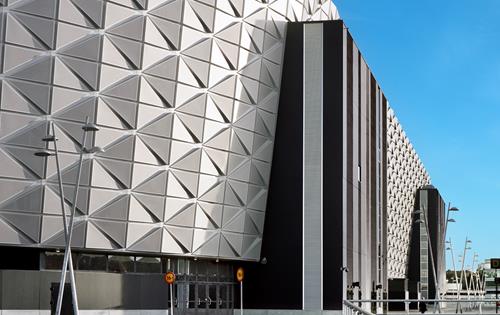Juvelen
Uppsala’s new office building Juvelen shimmers like a diamond, a mere stone’s throw from Uppsala train station. The spectacular triangular building has been built and developed by Skanska, with tough demands for both environmental performance and flexibility. Assemblin has been responsible for the electrical, ventilation, heating and sanitation installations.
Juvelen is an eye-catcher, with the triangles forming the building’s main theme – both in the façade cladding and in the triangular shape of the property. An office building with flexibility as its watchword, with demanding environmental ambitions, has set a high bar for Skanska, which built and developed the property. This has put the focus firmly on coordination for all of the parties involved.
“The challenge has been to deliver a coordinated product that reflects the building’s stringent requirements. In achieving that we benefited greatly from Assemblin’s installers for heat and sanitation, ventilation and electricity being co-located, in other words working side by side at the same premises,” says Per Eriksson, Project Manager at Assemblin.
Assemblin has been responsible for the electrical, ventilation, heating and sanitation installations at Juvelen. There has been close collaboration with Skanska, and when it came to tenant customisations, Assemblin was involved at a very early stage. In this way, it has been possible to deliver more cost-effective products and achieve a high level of customer satisfaction.
Deep green level
Juvelen is one of Skanska’s most sustainable buildings to date, and is referred to as a ‘deep green’ project, which means that both the construction process and the final product have had a virtually non-existent negative environmental impact. In addition, the project has been certified with the LEED environmental certification scheme’s highest level, Platinum.
“In general Skanska has very high goals and high environmental ambitions, but with Juvelen we wanted to go one step further and test our own boundaries,” says Fredrik Hjortzén, Business Developer at Skanska.
All Assemblin’s design and production have been adapted to the tough environmental requirements. For example, only products with a building product declaration were used, and production methods were also adapted to meet the zero landfill requirement for waste, according to Per Eriksson.
One of the basic environmental prerequisites for the project was Skanska’s own patented ‘Deep Green Cooling’ cooling system. This involves a series of drilled energy wells that both utilise the temperature in the bedrock for comfort cooling and preheat the outdoor air for comfort heating.
“We then distribute this though our technical installation that provides each storey with cooling and heating, depending on need. The system delivers very low resource consumption compared to traditional heating and cooling systems,” comments Per Eriksson.
Digital tools
The project used a project server called Apricon, which provided easy access to documents. Having all the material available digitally and not having documents lying around everywhere was an advantage particularly in the design and review phase,” says Per Eriksson.
“For the fitters, it has also been easy to access updated documents directly on site using a tablet or mobile phone.”
The inspections have been carried out using the BIM 360 Field platform, which involves working with a site plan and adding pins for comments, which are allocated an ID number. You can then add text, an ordinance reference or photos to the ID number.
“The fact that you can attach photos to the comments makes everything that much easier. Sometimes it takes a while before you can sign off on an inspection point, so it’s great to be able to refresh your memory with a picture instead of just text,” Per emphasises.
Safety and environmental inspections have been carried out using the Buildsafe app, where, like the BIM 360 Field software, photos can be added, so that all relevant parties can be informed of any comments. A much more reliable way of working than the loose printed records that were previously used, according to Per.
Digital tools were also used to facilitate logistics. Juvelen is located in central Uppsala and so the logistics presented a challenge. During the initial stage of the project, when Assemblin’s heaviest transports were arriving on site, only one-way traffic could be permitted on the construction site because of space restrictions. As the building is a prefab, there was also a constant influx of large concrete elements. The logistics issue was solved with a web-based unloading calendar, in which the various operators could book a slot for transports on to the site. That ensured as smooth a flow as possible, despite the limited space.
Flexible premises
Juvelen’s so-called base building, which consisted of a first stage and the building’s frame, required great flexibility because at the start of the construction process it was not clear who the tenants were who would be moving into the property. The responsible architectural firm solved this with a modular system, in which the floors were divided into a grid with corridors, with each square forming a separate module. Tenant customisations have since been completed using system walls to form rooms based on the tenant’s preferred floor plan. Each module was equipped with an air management system, radiators for thermal comfort and sprinklers. The electricity is provided via trunking rails, from where power and control is run to socket terminals and lighting.
“Thanks to these installations, very little effort is required to adapt the floors in Juvelen to individual tenant requirements,” says Per Eriksson.
Initially, the intention was for tenants’ electricity consumption to be sub-metered and invoiced via the rent.
This was revised by the developer some way into the project so that all tenants will now pay for their own electricity consumption. Assemblin had to redesign the building’s electrical circuit and create a new electrical distribution system that allowed for separate electricity metering. As the floors were built to house one to three different tenants, it was also necessary to be able to easily switch from metering all three distribution boards together to metering each one individually.
Most of the tenants at Juvelen are conventional office tenants without any special customisation requirements, but for some Assemblin has had to customise its installations.
“For example, we have adapted the design and installation in the building for a restaurant business. Some tenants have also needed server rooms, which has mainly affected the heating and sanitation and ventilation systems; some have needed uninterruptible power supplies (UPS), and in one case an especially high-performance data network (CAT7) was requested,” says Per Eriksson.
Acclaimed project
In 2020, Juvelen was nominated for Building of the Year, the most prestigious award in Sweden in the urban development sector. However, the building had also been nominated back in 2016, before work even started on it, in one of the world’s largest architectural competitions: the World Architecture Festival.
Tenant BASE10:
“We are very pleased with Assemblin’s adaptations”
Three of Juvelen’s eight floors house the coworking centre BASE10, run by entrepreneurs Jason Dainter and Kristofer Klerfalk in collaboration with Uppsala Municipality and Region Uppsala.
BASE10 offers help and support for start-ups and currently has over 900 members, who are given access to workplaces, meeting rooms and private offices at the company’s premises in Juvelen.
BASE10 used to be housed at another address in Uppsala, but chose to move its operations to Juvelen because of the building’s central location and unique architecture.
“The fact that Juvelen is so close to Uppsala train station makes it easier for people who come here from both Stockholm and Arlanda airport. In addition, it is hugely inspiring to work in such an eye-catching building – it nurtures the creativity of our members,” says Jason Dainter.
Because BASE10 has three floors in the building, they have been able to create separate zones for different purposes. One of the floors is designed for greater social interaction, while the third floor has a quieter profile with distinct office spaces.
The fact that the building is LEED certified was also something that was attractive, as the sustainability issue is very important for many of the coworking centre’s members. The fact that BASE10 came on board at an early stage means that they have had the opportunity to design the premises to meet their specific needs. On each of their floors, access systems have been installed so that members can easily and safely enter and leave the building. Digital signs have also been installed at each meeting room, where guests can easily check in for their meetings.
“We are very pleased with the adaptations that Assemblin has made for us. The access systems are both practical and stylish and are a good match with the rest of the interior,” Jason points out.



